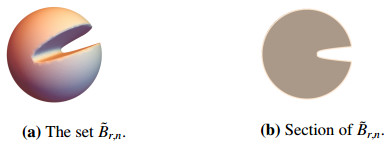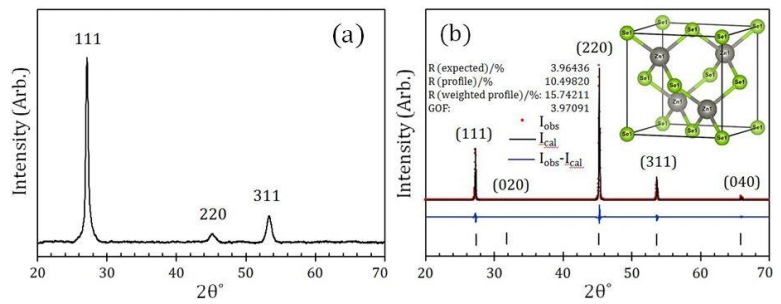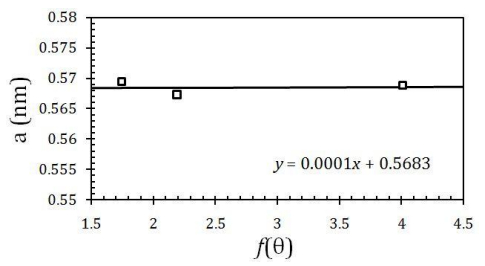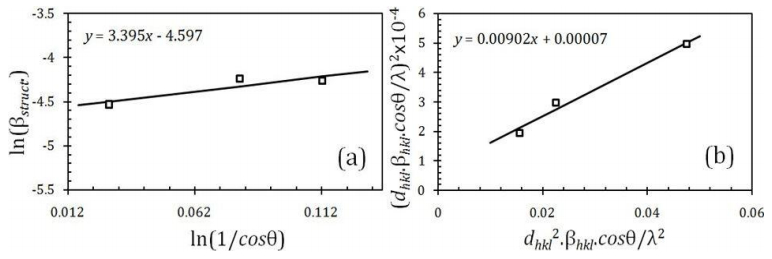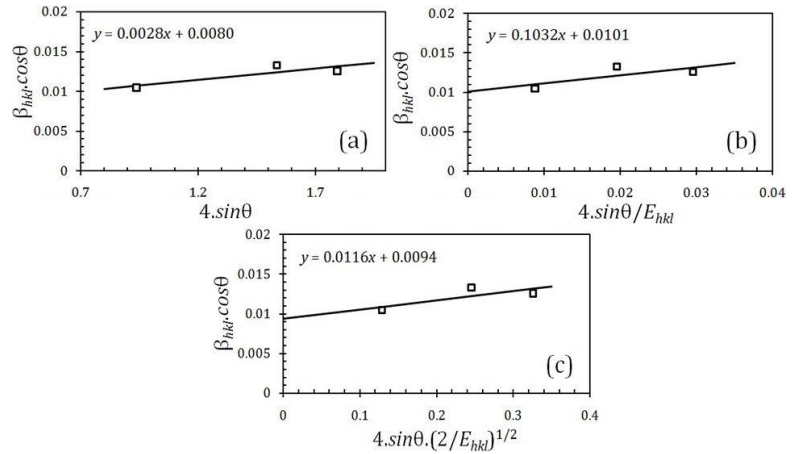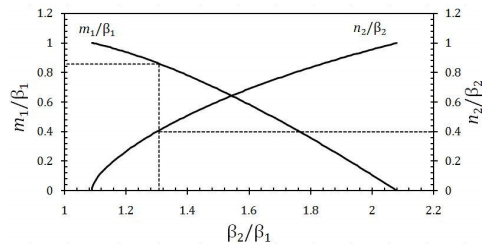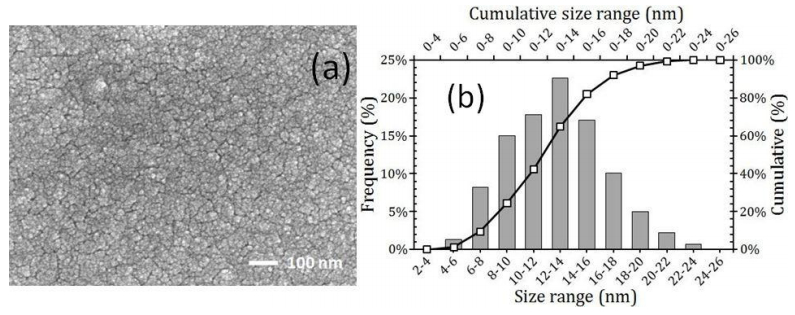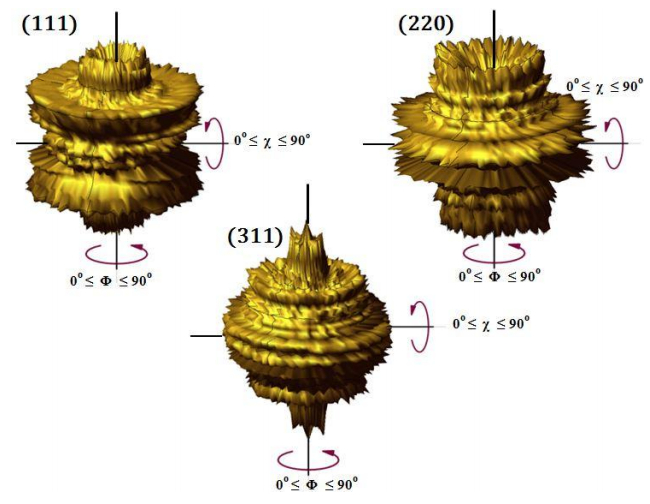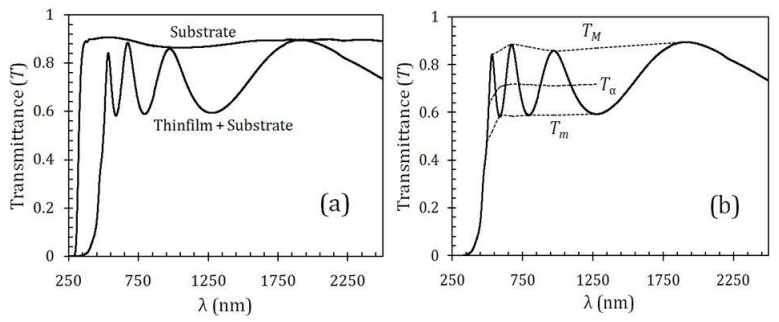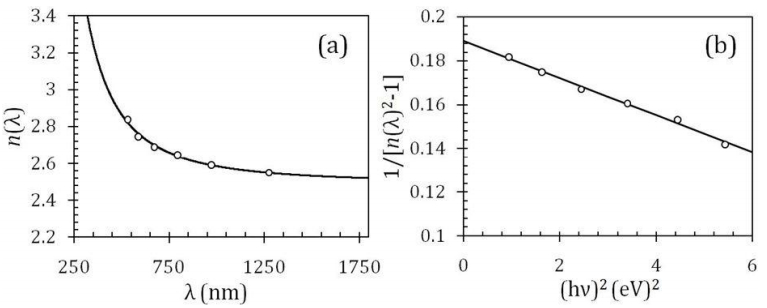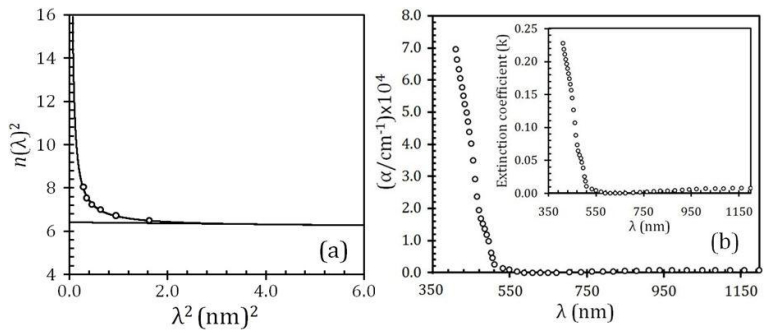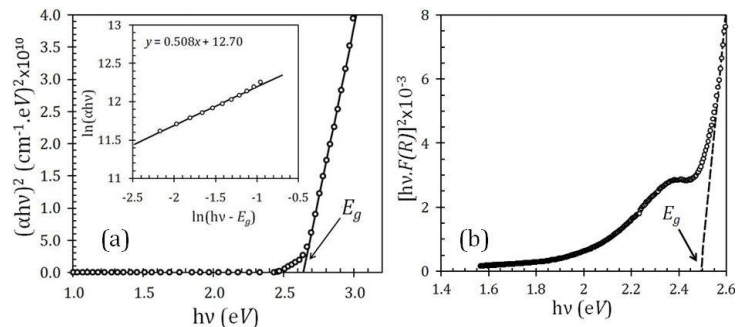Zinc-selenide thin film was prepared on a soda-lime glass substrate by thermal vapor deposition technique. The X-ray diffraction data confirmed the cubic zincblende structure with a preferred orientation along (111) plane. Different models such as Debye-Scherrer, Size-Strain plot, Williamson-Hall, uniform stress deformation model and uniform deformation energy density model and the so called approximation model were adopted to analyse the XRD data. Detailed microstructural parameters such as crystallite size, strain, stress, isotropic energy density, dislocation denstiy were reported and discussed in comparison with scanning electron microscopy data. The transmission spectra was obtained by UV-Vis-NIR spectrometer in the range of 250–2500 nm at room temperature. Important optical constantssuch as refractive index and dielectric constant was estimated using Swanepoel’s envelope method. The same method was used to check the thin film thickness which was found to be ~374.9 nm and this thickness was further confirmed by Scanning Electron Microscopy (368.3 ± 19.1 nm). The optical band gap was estimated to be 2.64 eV. The dispersion of refractive index was discussed interms of empirical Cauchy dispersion relation and the dispersion was further analysed by Wemple-DiDomenico Single oscillator model which provide physically meaningful parameters such as static refractive index, oscillator energy and dispersion energy. Both the structural and optical data not only complemented each other but also implied that good quality Zinc-selenide thin film could be deposited on ordinary glass substrates.
1.
Introduction and statement of the main results
This paper presents a monotonicity approach to the study of the asymptotic behavior and unique continuation from the edge of a crack for solutions to the following class of elliptic equations
where Ω⊂RN+1 is a bounded open domain, Γ⊂RN is a closed set, N≥2, and the potential f satisfies either a negligibility condition with respect to the inverse-square weight, see assumptions (H1-1)–(H1-3), or some suitable integrability properties, see assumptions (H2-1)–(H2-5) below.
We recall that the strong unique continuation property is said to hold for a certain class of equations if no solution, besides possibly the zero function, has a zero of infinite order. Unique continuation principles for solutions to second order elliptic equations have been largely studied in the literature since the pioneering contribution by Carleman [6], who derived unique continuation from some weighted a priori inequalities. Garofalo and Lin in [20] studied unique continuation for elliptic equations with variable coefficients introducing an approach based on the validity of doubling conditions, which in turn depend on the monotonicity property of the Almgren type frequency function, defined as the ratio of scaled local energy over mass of the solution near a fixed point, see [4].
Once a strong unique continuation property is established and infinite vanishing order for non-trivial solutions is excluded, the problem of estimating and possibly classifying all admissible vanishing rates naturally arises. For quantitative uniqueness and bounds for the maximal order of vanishing obtained by monotonicity methods we cite e.g., [23]; furthermore, a precise description of the asymptotic behavior together with a classification of possible vanishing orders of solutions was obtained for several classes of problems in [15,16,17,18,19], by combining monotonicity methods with blow-up analysis for scaled solutions.
The problem of unique continuation from boundary points presents peculiar additional difficulties, as the derivation of monotonicity formulas is made more delicate by the interference with the geometry of the domain. Moreover the possible vanishing orders of solutions are affected by the regularity of the boundary; e.g., in [15] the asymptotic behavior at conical singularities of the boundary has been shown to depend of the opening of the vertex. We cite [2,3,15,24,29] for unique continuation from the boundary for elliptic equations under homogeneous Dirichlet conditions. We also refer to [28] for unique continuation and doubling properties at the boundary under zero Neumann conditions and to [11] for a strong unique continuation result from the vertex of a cone under non-homogeneous Neumann conditions.
The aforementioned papers concerning unique continuation from the boundary require the domain to be at least of Dini type. With the aim of relaxing this kind of regularity assumptions, the present paper investigates unique continuation and classification of the possible vanishing orders of solutions at edge points of cracks breaking the domain, which are then highly irregular points of the boundary.
Elliptic problems in domains with cracks arise in elasticity theory, see e.g., [9,22,25]. The high non-smoothness of domains with slits produces strong singularities of solutions to elliptic problems at edges of cracks; the structure of such singularities has been widely studied in the literature, see e.g., [7,8,12] and references therein. In particular, asymptotic expansions of solutions at edges play a crucial role in crack problems, since the coefficients of such expansions are related to the so called stress intensity factor, see e.g., [9].
A further reason of interest in the study of problem (1.1) can be found in its relation with mixed Dirichlet/Neumann boundary value problems. Indeed, if we consider an elliptic equation associated to mixed boundary conditions on a flat portion of the boundary Λ=Λ1∪Λ2, more precisely a homogeneous Dirichlet boundary condition on Λ1 and a homogeneous Neumann condition on Λ2, an even reflection through the flat boundary Λ leads to an elliptic equation satisfied in the complement of the Dirichlet region, which then plays the role of a crack, see Figure 1; the edge of the crack corresponds to the Dirichlet-Neumann junction of the original problem. In [14] unique continuation and asymptotic expansions of solutions for planar mixed boundary value problems at Dirichlet-Neumann junctions were obtained via monotonicity methods; the present paper is in part motivated by the aim of extending to higher dimensions the monotonicity formula obtained in [14] in the 2-dimensional case, together with its applications to unique continuation. For some regularity results for second-order elliptic problems with mixed Dirichlet-Neumann type boundary conditions we refer to [21,27] and references therein.
In the generalization of the Almgren type monotonicity formula of [14] to dimensions greater than 2, some new additional difficulties arise, besides the highly non-smoothness of the domain: the positive dimension of the edge, a stronger interference with the geometry of the domain, and some further technical issues, related e.g., to the lack of conformal transformations straightening the edge. In particular, the proof of the monotonicity formula is based on the differentiation of the Almgren quotient defined in (4.9), which in turn requires a Pohozaev type identity formally obtained by testing the equation with the function ∇u⋅x; however our domain with crack doesn't verify the exterior ball condition (which ensures L2-integrability of second order derivatives, see [1]) and ∇u⋅x could be not sufficiently regular to be an admissible test function.
In this article a new technique, based on an approximation argument, is developed to overcome the aforementioned difficulty: we construct first a sequence of domains which approximate Ω∖Γ, satisfying the exterior ball condition and being star-shaped with respect to the origin, and then a sequence of solutions of an approximating problem on such domains, converging to the solution of the original problem with crack. For the approximating problems enough regularity is available to establish a Pohozaev type identity, with some remainder terms due to interference with the boundary, whose sign can nevertheless be recognized thanks to star-shapeness conditions. Then, passing to the limit in Pohozaev identities for the approximating problems, we obtain inequality (3.11), which is enough to estimate from below the derivative of the Almgren quotient and to prove that such quotient has a finite limit at 0 (Lemma 4.7). Once a finite limit of the Almgren frequency is shown to exist, a blow-up analysis for scaled solutions allows us to prove strong unique continuation and asymptotics of solutions.
In order to state the main results of the present paper, we start by introducing our assumptions on the domain. For N≥2, we consider the set
where g:RN−1→R is a function such that
Let us observe that assumption (1.2) is not a restriction but just a selection of our coordinate system and, from (1.2) and (1.3), it follows that
Moreover we assume that
for any x′∈B′ˆR:={x′∈RN−1:|x′|<ˆR}, for some ˆR>0. This condition says that ¯RN∖Γ is star-shaped with respect to the origin in a neighbourood of 0. It is satisfied for instance if the function g is concave in a neighborhood of the origin.
We are interested in studying the following boundary value problem
where BˆR={x∈RN+1:|x|<ˆR}, for some function f:BˆR→R such that f is measurable and bounded in BˆR∖Bδ for every δ∈(0,ˆR). We consider two alternative sets of assumptions: we assume either that
where the function ξf is defined as
or that
and
where
for every r∈(0,ˆR),h∈L∞loc(BˆR∖{0}).
Conditions (H1-1)–(H1-3) are satisfied e.g., if |f(x)|=O(|x|−2+δ) as |x|→0 for some δ>0, whereas assumptions (H2-1)–(H2-5) hold e.g., if f∈W1,∞loc(BˆR∖{0}) and f,∇f∈Lp(BˆR) for some p>N+12. We also observe that condition (H2-1) is satisfied if f belongs to the Kato class Kn+1, see [13].
In order to give a weak formulation of problem (1.6), we introduce the space H1Γ(BR) for every R>0, defined as the closure in H1(BR) of the subspace
We observe that actually
where τΓ denotes the trace operator on Γ, as one can easily deduce from [5], taking into account that the capacity of ∂Γ in RN+1 is zero, since ∂Γ is contained in a 2-codimensional manifold.
Hence we say that u∈H1(BˆR) is a weak solution to (1.6) if
In the classification of the possible vanishing orders and blow-up profiles of solutions, the following eigenvalue problem on the unit N-dimensional sphere with a half-equator cut plays a crucial role. Letting SN={(x′,xN,xN+1):|x′|2+x2N+x2N+1=1} be the unit N-dimensional sphere and
we consider the eigenvalue problem
We say that μ∈R is an eigenvalue of (1.7) if there exists an eigenfunction ψ∈H10(SN∖Σ), ψ≢0, such that
for all ϕ∈H10(SN∖Σ). By classical spectral theory, (1.7) admits a diverging sequence of real eigenvalues with finite multiplicity {μk}k≥1; moreover these eigenvalues are explicitly given by the formula
see Appendix A. For all k∈N∖{0}, let Mk∈N∖{0} be the multiplicity of the eigenvalue μk and
In particular {Yk,m:k∈N∖{0},m=1,2,…,Mk} is an orthonormal basis of L2(SN).
The main result of this paper provides an evaluation of the behavior at 0 of weak solutions u∈H1(BˆR) to the boundary value problem (1.6).
Theorem 1.1. Let N≥2 and u∈H1(BˆR)∖{0} be a non-trivial weak solution to (1.6), with f satisfying either assumptions (H1-1)–(H1-3) or (H2-1)–(H2-5). Then, there exist k0∈N, k0≥1, and an eigenfunction of problem (1.7) associated with the eigenvalue μk0 such that
in H1(B1).
We mention that a stronger version of Theorem 1.1 will be given in Theorem 6.7.
As a direct consequence of Theorem 1.1 and the boundedness of eigenfunctions of (1.7) (see Appendix A), the following point-wise upper bound holds.
Corollary 1.2. Under the same assumptions as in Theorem 1.1, let u∈H1(BˆR) be a non-trivial weak solution to (1.6). Then, there exists k0∈N, k0≥1, such that
We observe that, due to the vanishing on the half-equator Σ of the angular profile ψ appearing in (1.10), we cannot expect the reverse estimate |u(x)|≥c|x|k0/2 to hold for x close to the origin.
A further relevant consequence of our asymptotic analysis is the following unique continuation principle, whose proof follows straightforwardly from Theorem 1.1.
Corollary 1.3. Under the same assumptions as in Theorem 1.1, let u∈H1(BˆR) be a weak solution to (1.6) such that u(x)=O(|x|k) as |x|→0, for any k∈N. Then u≡0 in BˆR.
Theorem 6.7 will actually give a more precise description on the limit angular profile ψ: if Mk0≥1 is the multiplicity of the eigenvalue μk0 and {Yk0,i:1≤i≤Mk0} is as in (1.9), then the eigenfunction ψ in (1.10) can be written as
where the coefficients βi are given by the integral Cauchy-type formula (6.40).
The paper is organized as follows. In Section 2 we construct a sequence of problems on smooth sets approximating the cracked domain, with corresponding solutions converging to the solution of problem (1.6). In Section 3 we derive a Pohozaev type identity for the approximating problems and consequently inequality (3.11), which is then used in Section 4 to prove the existence of the limit for the Almgren type quotient associated to problem (1.6). In Section 5 we perform a blow-up analysis and prove that scaled solutions converge in some suitable sense to a homogeneous limit profile, whose homogeneity order is related to the eigenvalues of problem (1.7) and whose angular component is shown to be as in (1.11) in Section 6, where an auxiliary equivalent problem with a straightened crack is constructed. Finally, in the appendix we derive the explicit formula (1.8) for the eigenvalues of problem (1.7).
Notation. We list below some notation used throughout the paper.
− For all r>0, Br denotes the open ball {x=(x′,xN,xN+1)∈RN+1:|x|<r} in RN+1 with radius r and center at 0.
− For all r>0, ¯Br={x=(x′,xN,xN+1)∈RN+1:|x|≤r} denotes the closure of Br.
− For all r>0, B′r denotes the open ball {x=(x′,xN)∈RN:|x|<r} in RN with radius r and center at 0.
−dS denotes the volume element on the spheres ∂Br, r>0.
2.
Approximation problem
We first prove a coercivity type result for the quadratic form associated to problem (1.6) in small neighbourhoods of 0.
Lemma 2.1. Let f satisfy either (H1-1) or (H2-1). Then there exists r0∈(0,ˆR) such that, for any r∈(0,r0] and u∈H1(Br),
and
where
Remark 2.2. For future reference, it is useful to rewrite (2.1) as
for all u∈H1(Br) and r∈(0,r0].
The proof of Lemma 2.1 under assumption (H1-1) is based on the following Hardy type inequality with boundary terms, due to Wang and Zhu [30].
Lemma 2.3 ([30], Theorem 1.1). For every r>0 and u∈H1(Br),
Proof of Lemma 2.1. Let us first prove the lemma under assumption (H1-1). To this purpose, let r0∈(0,ˆR) be such that
Using the definition of ξf(r) (H1-3) and (2.5), we have that for any r∈(0,ˆR) and u∈H1(Br)
Thus, for every 0<r≤r0, from (2.6) and (2.7), we obtain that
and this completes the proof of (2.1) under assumption (H1-1).
Now let us prove the lemma under assumption (H2-1). Let r0∈(0,ˆR) be such that
From the definition of η(r,f) (H2-5) it follows that for any r∈(0,ˆR) and u∈H1(Br)
Thus, for every 0<r≤r0, from (2.8) and (2.9) we deduce that
hence concluding the proof of (2.1) under assumption (H2-1).
We observe that estimate (2.2) follows from the definition of ω in (2.3), (2.6), and (2.8).
Now we are going to construct suitable regular sets which are star-shaped with respect to the origin and which approximate our cracked domain. In order to do this, for any n∈N∖{0} let fn:R→R be defined as
so that fn∈C2(R), fn(t)≥n|t| and fn increases for all t>0 and decreases for all t<0; furthermore
For all r>0 we define
see Figure 2.
Let ˜γr,n⊂∂˜Br,n be the subset of Br defined as
and ˜Sr,n denote the set given by ∂˜Br,n∖˜γr,n. We note that, for any fixed r>0, the set ˜γr,n is not empty and ˜Br,n≠Br provided n is sufficiently large.
Lemma 2.4. Let 0<r≤ˆR. Then, for all n∈N∖{0}, the set ˜Br,n is star-shaped with respect to the origin, i.e., x⋅ν≥0 for a.e. x∈∂˜Br,n, where ν is the outward unit normal vector.
Proof. If ˜γr,n is empty, then ˜Br,n=Br and the conclusion is obvious. Let ˜γr,n be not empty.
The thesis is trivial if one considers a point x∈˜Sr,n.
If x∈˜γr,n, then x=(x′,g(x′)+fn(xN+1),xN+1) and the outward unit normal vector at this point is given by
hence we have that
since g(x′)−∇g(x′)⋅x′≥0 by assumption (1.5) and fn(xN+1)−xN+1f′n(xN+1)≥0 by (2.10).
From now on, we fix u∈H1(BˆR)∖{0}, a non-trivial weak solution to problem (1.6), with f satisfying either (H1-1)–(H1-3) or (H2-1)–(H2-5). Since u∈H1Γ(BˆR), there exists a sequence of functions gn∈C∞0,Γ(¯BˆR) such that gn→u in H1(BˆR). We can choose the functions gn in such a way that
with
Remark 2.5. We observe that gn≡0 in Br0∖˜Br0,n. Indeed, if x=(x′,xN,xN+1)∈Br0∖˜Br0,n, then
so that (x′,xN)∈Γ. Moreover
with M as in (2.13). Hence either |xN+1|≤Mn or r20≥x2N≥(n|xN+1|−M)2≥n22|xN+1|2−M2. Thus |xN+1|≤√2(r20+M2)n<˜Cn, if we choose ˜C as in (2.13). Then gn(x)=0 in view of (2.12).
Now we construct a sequence of approximated solutions {un}n∈N on the sets ˜Br0,n. For each fixed n∈N, we claim that there exists a unique weak solution un to the boundary value problem
Letting
we have that un weakly solves (2.14) if and only if vn∈H1(˜Br0,n) is a weak solution to the homogeneous boundary value problem
i.e.,
Lemma 2.6. Let r0 be as in Lemma 2.1. Then, for all n∈N, problem (2.15) has one and only one weak solution vn∈H10(˜Br0,n), where ˜Br0,n is defined in (2.11).
Proof. Let us consider the bilinear form
for every v,w∈H10(˜Br0,n). Lemma 2.1 implies that a is coercive on H10(˜Br0,n). Furthermore, from estimate (2.4) we easily deduce that a is continuous. The thesis then follows from the Lax-Milgram Theorem.
Proposition 2.7. Under the same assumptions of Lemma 2.6, there exists a positive constant C>0 such that ‖ for every n\in\mathbb{N} , where v_n is extended trivially to zero in B_{r_0}\setminus \tilde{B}_{{r_0}, n} .
Proof. Let us observe that fg_n and -\Delta g_n are bounded in H^{-1}(B_{r_0}) as a consequence of the boundedness of g_n in H^1(B_{r_0}) : indeed, using (2.4), one has that, for any \phi\in H^1_0(B_{r_0}) ,
for some c_1 > 0 independent on n and \phi , and
for some c_2 > 0 independent on n and \phi . Thus from (2.15)–(2.17) and Lemma 2.1, it follows that
for some c_3 > 0 independent on n . This completes the proof.
Proposition 2.8. Under the same assumptions of Lemma 2.6, we have that u_n\rightharpoonup u weakly in H^1(B_{r_0}) , where u_n is extended trivially to zero in B_{r_0}\setminus \tilde{B}_{r_0, n} .
Proof. We observe that the trivial extension to zero of u_n in B_{r_0}\setminus \tilde{B}_{r_0, n} belongs to H^1(B_{r_0}) since the trace of u_n on \tilde{\gamma}_{r_0, n} is null in view of Remark 2.5.
From Proposition 2.7 it follows that there exist \tilde{v}\in H^1_0(B_{r_0}) and a subsequence \{v_{n_k}\} of \{v_n\} such that v_{n_k}\rightharpoonup \tilde{v} weakly in H^1_0(B_{r_0}) . Then u_{n_k} = v_{n_k}+g_{n_k}\rightharpoonup \tilde{u} weakly in H^1(B_{r_0}) , where \tilde{u}: = \tilde{v}+u . Let \phi\in C^\infty_c(B_{r_0}\setminus \Gamma) . Arguing as in Remark 2.5, we can prove that \phi\in H^1_0(\tilde{B}_{r_0, n_k}) for all sufficiently large k . Hence, from (2.14) it follows that, for all sufficiently large k ,
where u_{n_k} is extended trivially to zero in B_{r_0}\setminus \tilde{B}_{r_0, n_k} . Passing to the limit in (2.18), we obtain that
for every \phi\in C^\infty_c(B_{r_0}\setminus \Gamma) . Furthermore \tilde{u} = u on \partial B_{r_0} in the trace sense: indeed, due to compactness of the trace map \gamma:H^1(B_{r_0})\to L^2(\partial B_{r_0}) , we have that \gamma(u_{n_k})\rightarrow\gamma(\tilde{u}) in L^2(\partial B_{r_0}) and \gamma(u_{n_k})\; \! = \; \!\gamma(g_{n_k})\to \; \!\gamma(u) in L^2(\partial B_{r_0}) , since g_n\rightarrow u\ \text{in}\ H^1(B_{r_0}) .
Finally, we prove that \tilde{u}\in H^1_\Gamma(B_{r_0}) . To this aim, let \Gamma_\delta = \{(x', x_N)\in \mathbb{R}^N:\, x_N\geq g(x')+\delta\} for every \delta > 0 . For every \delta > 0 we have that \Gamma_\delta \cap B_{r_0}\subset B_{r_0}\setminus \tilde{B}_{r_0, n} provided n is sufficiently large. Hence, since u_{n} is extended trivially to zero in B_{r_0}\setminus \tilde{B}_{r_0, n} , we have that, for every \delta > 0 , u_n\in H^1_{\Gamma_\delta}(B_{r_0}) provided n is sufficiently large. Since H^1_{\Gamma_\delta}(B_{r_0}) is weakly closed in H^1(B_{r_0}) , it follows that \tilde{u}\in H^1_{\Gamma_\delta}(B_{r_0}) for every \delta > 0 , and hence \tilde{u}\in H^1_\Gamma(B_{r_0}) .
Thus \tilde{u} weakly solves
Now we consider the function U: = \tilde{u}-u : it weakly solves the following problem
Testing Eq (2.19) with U itself and using Lemma 2.1, we obtain that
so that U = 0 , hence u = \tilde{u} . By Urysohn's subsequence principle, we can conclude that u_n\rightharpoonup u weakly in H^1(B_{r_0}) .
Our next aim is to prove strong convergence of the sequence \{u_n\}_{n\in\mathbb{N}} to u in H^1(B_{r_0}) .
Proposition 2.9. Under the same assumptions of Lemma 2.6, we have that u_n\rightarrow u in H^1(B_{r_0}) .
Proof. From Proposition 2.8 we deduce that v_n\rightharpoonup 0 in H^1(B_{r_0}) , hence testing (2.15) with v_n itself, we have that
as n\rightarrow\infty . Thus, from Lemma 2.1, we deduce that \Vert v_n\Vert_{H^1_0(B_{r_0})}\rightarrow 0 as n\rightarrow\infty , hence v_n\rightarrow 0 in H^1(B_{r_0}) . This yields that u_n = g_n+v_n\rightarrow u in H^1(B_{r_0}) .
3.
Pohozaev identity
In this section we derive a Pohozaev type identity for u_n in which we will pass to the limit using Proposition 2.9. For every r\in(0, r_0) and v\in H^1(B_r) , we define
Lemma 3.1. Let 0 < r < r_0 . There exists n_0 = n_0(r)\in\mathbb{N}\setminus\{0\} such that, for all n\geq n_0 ,
Proof. Since u_n solves (2.14) in the domain \tilde{B}_{r_0, n} , which satisfies the exterior ball condition, and fu_n\in \; \!\! L^2_{\text{loc}}(\tilde{B}_{r_0, n}\setminus\{0\}) , by elliptic regularity theory (see [1]) we have that u_n\in H^2(\tilde{B}_{r, n}\setminus B_\delta) for all r\in (0, r_0) , n sufficiently large and all \delta < r_n , where r_n is such that B_{r_n}\subset \tilde{B}_{r, n} . Since
there exists a sequence \{\delta_k\}_{k\in\mathbb{N}}\subset (0, r_n) such that \lim_{k\rightarrow\infty}\delta_k = 0 and
Testing (2.14) with x\cdot\nabla u_n and integrating over \tilde{B}_{r, n}\setminus B_{\delta_k} , we obtain that
Integration by parts allows us to rewrite the first term in (3.3) as
where we used that x = r\nu on \tilde{S}_{r, n} and that the tangential component of \nabla u_n on \tilde{\gamma}_{r, n} equals zero, thus \nabla u_n = \frac{\partial u_n}{\partial \nu}\nu on \tilde{\gamma}_{r, n} . Furthermore, by direct calculations, the first term in (3.4) can be rewritten as
Taking into account (3.3)–(3.5), we obtain that
Under assumptions (H1-1)–(H1-3), the Hardy inequality (2.5) implies that f\, u_n(x\cdot\nabla u_n)\in L^1(B_r) and hence
On the other hand, if (H2-1)–(H2-5) hold, we can use the Divergence Theorem to obtain that
Since, under assumptions (H2-1)–(H2-5), \big(\nabla f\cdot x+(N+1)f\big)u_n^2 \in L^1(B_r) , we can pass to the limit as k\to\infty in (3.8) taking into account also (3.2), thus obtaining that
Letting k\rightarrow +\infty in (3.6), by (3.2), (3.7), and (3.9), we obtain (3.1).
Combining Lemma 3.1 with the fact that the domains \tilde{B}_{r, n} (defined as in (2.11)) are star-shaped with respect to the origin, we deduce the following inequality.
Corollary 3.2. Let 0 < r < r_0 . There exists n_0 = n_0(r)\in\mathbb{N}\setminus\{0\} such that, for all n\geq n_0 ,
Proof. In view of (3.1), the left-hand side of (3.10) is equal to \frac{1}{2}\int_{\tilde{\gamma}_{r, n}}\big|\frac{\partial u_n}{\partial \nu}\big|^2 x\cdot\nu\, dS , which is in fact non-negative, since x\cdot\nu\geq 0 on \tilde{\gamma}_{r, n} by Lemma 2.4.
Passing to the limit in (3.10) as n\to\infty , a similar inequality can be derived for u .
Proposition 3.3. Let u solve (1.6), with f satisfying either (H1-1)–(H1-3) or (H2-1)–(H2-5). Then, for a.e. r\in (0, r_0) , we have that
and
Proof. In order to prove (3.11), we pass to the limit inside inequality (3.10). As regards the first term, it is sufficient to observe that
for each fixed r\in (0, r_0) , as a consequence of Proposition 2.9. In order to deal with the second term, we observe that, by strong H^1 -convergence of u_n to u ,
Letting
(3.13) implies that F_n\rightarrow 0 in L^1(0, r_0) . Then there exists a subsequence F_{n_k} such that F_{n_k}(r)\rightarrow 0 for a.e. r\in (0, r_0) , hence
for a.e. r\in (0, r_0) . In a similar way, we obtain that
It remains to prove the convergence of \mathcal R(r, u_n) . Under the set of assumptions (H1-1)–(H1-3), we first write
The Hölder inequality, (2.5), and Proposition 2.9 imply that
and
as n\rightarrow\infty , for a.e. r\in (0, r_0) , since \xi_f(r) is finite a.e. as a consequence of assumption (H1-2). Hence, from (3.14) we deduce that
under assumptions (H1-1)–(H1-3). To prove (3.15) under assumptions (H2-1)–(H2-5), we first use Proposition 2.9 and the Hölder inequality to observe that
as n\rightarrow\infty , for a.e. r\in (0, r_0) , since \eta(r, \nabla f\cdot x) and \eta(r, f) are finite a.e. as a consequence of assumptions (H2-4) and (H2-2) and \{u_n+u\}_n is bounded in H^1(B_r) for every r\in (0, r_0) . Furthermore, by the fact that f is bounded far from the origin and the compactness of the trace map from H^1(B_r) to L^2(\partial B_r) , it follows that
for a.e. r\in (0, r_0) . Hence, passing to the limit in \mathcal R(r, u_n) we conclude the first part of the proof.
Finally (3.12) follows by testing (2.14) with u_n itself and passing to the limit arguing as above.
4.
The Almgren type frequency function
Let u\in H^1_\Gamma(B_{\hat{R}}) be a non trivial solution to (1.6). For every r\in (0, \hat{R}) we define
and
In the following lemma we compute the derivative of the function \mathcal{H} .
Lemma 4.1. We have that \mathcal{H}\in W^{1, 1}_{\mathrm{loc}}(0, \hat{R}) and
in a distributional sense and for a.e. r\in (0, \hat{R}) . Furthermore
Proof. First we observe that
Let \phi \in C^\infty_c(0, \hat{R}) . Since u, \nabla u\in L^2(B_{\hat{R}}) , we obtain that
where we set v(x) = \phi(|x|) . Thus we proved (4.3). Identity (4.4) follows from (4.3) and (3.12).
We now observe that the function \mathcal H is strictly positive in a neighbourhood of 0 .
Lemma 4.2. For any r\in (0, r_0] , we have that \mathcal{H}(r) > 0 .
Proof. Assume by contradiction that there exists r_1\in (0, r_0] such that \mathcal{H}(r_1) = 0 , so that the trace of u on \partial B_{r_1} is null and hence u\in H^1_0(B_{r_1}\setminus\Gamma) . Then, testing (1.6) with u , we obtain that
Thus, from Lemma 2.1 and (4.6) it follows that
which, together with Lemma 2.3, implies that u\equiv 0 in B_{r_1} . From classical unique continuation principles for second order elliptic equations with locally bounded coefficients (see e.g., [31]), we can conclude that u = 0 a.e. in B_{\hat{R}} , a contradiction.
Let us now differentiate the function \mathcal{D} and estimate from below its derivative.
Lemma 4.3. The function \mathcal{D} defined in (4.1) belongs to W^{1, 1}_{\mathrm{loc}}(0, \hat{R}) and
for a.e. r\in (0, r_0) .
Proof. We have that
for a.e. r\in (0, r_0) and in the distributional sense. Combining (3.11) and (4.8), we obtain (4.7).
Thanks to Lemma 4.2, the frequency function
is well defined. Using Lemmas 4.1, 4.3, and 2.1 we can estimate from below \mathcal N and its derivative.
Lemma 4.4. The function \mathcal{N} defined in (4.9) belongs to W^{1, 1}_{\mathrm{loc}}((0, r_0]) and
for a.e. r\in (0, r_0) , where
and
Furthermore,
and, for every \varepsilon > 0 , there exists r_\varepsilon > 0 such that
i.e., \liminf_{r\to 0^+}\mathcal N(r)\geq0 .
Proof. From Lemmas 4.1, 4.2, and 4.3, it follows that \mathcal{N}\in W^{1, 1}_{\mathrm{loc}}((0, r_0]) . From (4.4) we deduce that
and the proof of (4.10) easily follows from (4.3) and (4.7). To prove (4.12) and (4.13), we observe that (4.1) and (4.2), together with Lemma 2.1, imply that
for every r\in (0, r_0) , where \omega is defined in (2.3). Then (4.12) follows directly from (2.2). From either assumption (H1-1) or (H2-1) it follows that \lim_{r\to 0^+}r\omega(r) = 0 ; hence (4.14) implies (4.13).
Lemma 4.5. Let \nu_2 be as in (4.11). There exists a positive constant C_1 > 0 such that
for all r\in (0, r_0) , where
Proof. From Lemma 2.1 we deduce that, for all r\in (0, r_0) ,
where \omega(r) is defined in (2.3).
Let us first suppose to be under assumptions (H1-1)–(H1-3). Estimating the first term in the numerator of \nu_2(r) we obtain that
where we used (H1-3), Lemma 2.3, (4.17) and (2.6). Using Hölder inequality, (4.18), (2.6), and (4.17), the second term can be estimated as follows
For the last term we have that
Combining (4.18)–(4.20), we obtain that, for all r\in(0, r_0) ,
for some positive constant C_1 > 0 which does not depend on r .
Now let us suppose to be under assumptions (H2-1)–(H2-5). In this case, the definition of \mathcal R(r, u) allows us to rewrite \nu_2 as
From (H2-5), (4.17) and (2.8) it follows that
Therefore, we have that
and estimate (4.15) is proved also under assumptions (H2-1)–(H2-5), with C_1 = 4 .
Lemma 4.6. Letting r_0 be as in Lemma 2.1 and \mathcal{N} as in (4.9), there exists a positive constant C_2 > 0 such that
for all r\in (0, r_0) .
Proof. By Lemma 4.4, Schwarz's inequality, and Lemma 4.5, we obtain
for a.e. r\in (0, r_0) , where \alpha is defined in (4.16). Taking into account that \mathcal{N}(r)+\frac{N-1}{2} > 0 for all r\in(0, r_0) in view of (4.12) and \alpha\in L^1(0, r_0) thanks to assumptions (H1-2), (H2-2) and (H2-4), after integration over (r, r_0) it follows that
for any r\in (0, r_0) , thus proving estimate (4.21).
Lemma 4.7. The limit
exists and is finite. Moreover \gamma\geq0 .
Proof. Since \mathcal{N}'(r)\geq-C_1\alpha(r)\bigl[\mathcal{N}(r)+\frac{N-1}{2}\bigr] in view of (4.22) and \alpha\in L^1(0, r_0) by assumptions (H1-2), (H2-2) and (H2-4), we have that
therefore the limit of r\mapsto e^{C_1\int_0^r \alpha(s)\, ds}\bigl(\mathcal{N}(r)+\frac{N-1}{2}\bigr) as r\rightarrow 0^+ exists; hence the function \mathcal{N} has a limit as r\rightarrow 0^+ .
From (4.21) and (4.13) it follows that C_2\geq \gamma: = \lim_{r\rightarrow 0^+}\mathcal{N}(r) = \liminf_{r\rightarrow 0^+}\mathcal{N}(r)\geq0 ; in particular \gamma is finite.
A first consequence of the above analysis on the Almgren's frequency function is the following estimate of \mathcal{H}(r) .
Lemma 4.8. Let \gamma be as in Lemma 4.7 and r_0 be as in Lemma 2.1. Then there exists a constant K_1 > 0 such that
On the other hand, for any \sigma > 0 there exists a constant K_2(\sigma) > 0 depending on \sigma such that
Proof. By (4.22) and (4.21) we have that
Hence, from the fact that \alpha\in L^1(0, r_0) and Lemma 4.7, it follows that \mathcal{N}'\in L^1(0, r_0) . Therefore from (4.25) it follows that
where C_3 = C_1\big(C_2+\frac{N-1}2\big) and
We observe that, thanks to assumptions (H1-2), (H2-2) and (H2-4),
From (4.4) and (4.26) we deduce that, for a.e. r\in (0, r_0) ,
which, thanks to (4.27), after integration over the interval (r, r_0) , yields (4.23).
Let us prove (4.24). Since \gamma: = \lim_{r\rightarrow0^+}\mathcal{N}(r) , for any \sigma > 0 there exists r_\sigma > 0 such that \mathcal{N}(r) < \; \!\gamma +\; \! \sigma/2 for any r\in(0, r_\sigma) and hence
Integrating over the interval (r, r_\sigma) and by continuity of \mathcal{H} outside 0 , we obtain (4.24) for some constant K_2(\sigma) depending on \sigma .
5.
The blow-up argument
In this section we develop a blow-up analysis for scaled solutions, with the aim of classifying their possible vanishing orders. The presence of the crack produces several additional difficulties with respect to the classical case, mainly relying in the persistence of the singularity even far from the origin, all along the edge. These difficulties are here overcome by means of estimates of boundary gradient integrals (Lemma 5.5) derived by some fine doubling properties, in the spirit of [19], where an analogous lack of regularity far from the origin was instead produced by many-particle and cylindrical potentials.
Throughout this section we let u be a non trivial weak H^1(B_{\hat{R}}) -solution to equation (1.6) with f satisfying either (H1-1)–(H1-3) or (H2-1)–(H2-5). Let \mathcal{D} and \mathcal{H} be the functions defined in (4.1) and (4.2) and r_0 be as in Lemma 2.1. For \lambda\in (0, r_0) , we define the scaled function
We observe that w^\lambda \in H^1_{\Gamma_\lambda}(B_{\lambda^{-1}\hat{R}}) , where
and
i.e., w^\lambda weakly solves
Remark 5.1. From assumptions (1.2) and (1.3) we easily deduce that \mathbb{R}^{N+1}\setminus\Gamma_\lambda converges in the sense of Mosco (see [10,26]) to the set \mathbb{R}^{N+1}\setminus\tilde\Gamma , where
In particular, for every R > 0 , the weak limit points in H^1(B_R) as \lambda\to 0^+ of the family of functions \{w^\lambda\}_\lambda belong to H^1_{\tilde \Gamma}(B_R) .
Lemma 5.2. For \lambda\in (0, r_0) , let w^\lambda be defined in (5.1). Then \{w^\lambda\}_{\lambda\in (0, r_0)} is bounded in H^1(B_1) .
Proof. From (4.5) it follows that
By scaling and (2.1) we have that
From (5.5), (4.21), and (2.2) it follows that
for every \lambda\in (0, r_0) . The conclusion follows from (5.6) and (5.4), taking into account (2.5).
In the next lemma we prove a doubling type result.
Lemma 5.3. There exists C_4 > 0 such that
and
where w^\lambda is defined in (5.1).
Proof. By (4.12), (4.21), and (4.4), it follows that
Let R\in (1, 2] . For any \lambda < r_0/R , integrating over (\lambda, R\lambda) the above inequality and recalling that R\leq 2 , we obtain
The above estimates trivially hold also for R = 1 , hence (5.7) with C_4 = \max\{4^{C_2}, 2^{(N-1)/2}\} is established.
For every \lambda\in (0, r_0/2) and R\in [1, 2] , (5.7) yields
thus proving (5.8). A similar argument allows deducing (5.9) from (5.7).
Lemma 5.4. For every \lambda\in (0, r_0) , let w^\lambda be as in (5.1). Then there exist M > 0 and \lambda_0 > 0 such that, for any \lambda\in (0, \lambda_0) , there exists R_\lambda\in [1, 2] such that
Proof. From Lemma 5.2 we know that the family \{w^\lambda\}_{\lambda\in (0, r_0)} is bounded in H^1(B_1) . Moreover Lemma 5.3 implies that the set \{w^\lambda\}_{\lambda\in (0, r_0/2)} is bounded in H^1(B_2) and hence
For every \lambda\in (0, r_0/2) , the function f_\lambda(r) = \int_{B_r}|\nabla w^\lambda(x)|^2 dx is absolutely continuous in [0, 2] and its distributional derivative is given by
We argue by contradiction and assume that for any M > 0 there exists a sequence \lambda_n\rightarrow 0^+ such that
i.e.,
Integration of (5.11) over [1, 2] yields f_{\lambda_n}(2) > e^M f_{\lambda_n}(1) for every n\in\mathbb{N} and consequently
It follows that
Therefore, letting M\rightarrow +\infty and taking into account (5.10), we obtain that \liminf_{\lambda\rightarrow 0^+}f_\lambda(1) = 0 i.e.,
From (5.12) and boundedness of \{w^\lambda\}_{\lambda\in (0, r_0)} in H^1(B_1) there exist a sequence \tilde{\lambda}_n\rightarrow 0 and some w\in \; \! H^1(B_1) such that w^{\tilde{\lambda}_n}\rightharpoonup w in H^1(B_1) and
The compactness of the trace map from H^1(B_1) to L^2(\partial B_1) and (5.4) imply that
Moreover, by weak lower semicontinuity and (5.13),
Hence w\equiv \text{ const} in B_1 . On the other hand, in view of Remark 5.1, w\in H^1_{\tilde\Gamma}(B_1) so that w\equiv 0 in B_1 , thus contradicting (5.14).
Lemma 5.5. Let w^\lambda be as in (5.1) and R_\lambda be as in Lemma 5.4. Then there exists \overline{M} such that
Proof. Since
from (5.7), (5.8), Lemma 5.4, Lemma 5.2, and the fact that 1\leq R_\lambda\leq 2 , we deduce that, for every 0 < \lambda < \min\{\lambda_0, \frac{r_0}{2}\} ,
thus completing the proof.
Lemma 5.6. Let u\in H^1(B_{\hat{R}})\setminus\{0\} be a non-trivial weak solution to (1.6) with f satisfying either (H1-1)–(H1-3) or (H2-1)–(H2-5). Let \gamma be as in Lemma 4.7. Then
(i) there exists k_0\in\mathbb{N}\setminus\{0\} such that \gamma = \frac{k_0}2 ;
(ii) for every sequence \lambda_n \rightarrow 0^+ , there exist a subsequence \{\lambda_{n_k}\}_{k\in\mathbb{N}} and an eigenfunction \psi of problem (1.7) associated with the eigenvalue \mu_{k_0} such that \Vert \psi\Vert_{L^2(\mathbb{S}^N)} = 1 and
Proof. For \lambda\in (0, \min\{r_0, \lambda_0\}) , let w^\lambda be as in (5.1) and R_\lambda be as in Lemma 5.4. Let \lambda_n \rightarrow 0^+ . By Lemma 5.2, we have that the set \{w^{\lambda R_\lambda}: \lambda\in (0, \min\{r_0/2, \lambda_0\})\} is bounded in H^1(B_1) . Then there exists a subsequence \{\lambda_{n_k}\}_k such that w^{\lambda_{n_k}R_{\lambda_{n_k}}}\rightharpoonup w weakly in H^1(B_1) for some function w\in H^1(B_1) . The compactness of the trace map from H^1(B_1) into L^2(\partial B_1) and (5.4) ensure that
and, consequently, w\not\equiv 0 . Furthermore, in view of Remark 5.1 we have that w\in H^1_{\tilde \Gamma}(B_1) , where \tilde{\Gamma} is the set defined in (5.3).
Let \phi\in C^\infty_c(B_1\setminus \tilde{\Gamma}) . It is easy to verify that \phi\in C^\infty_c(B_1\setminus \Gamma_\lambda) provided \lambda is sufficiently small. Therefore, since w^{\lambda_{n_k}R_{\lambda_{n_k}}} weakly satisfies Eq (5.2) with \lambda = \lambda_{n_k}R_{\lambda_{n_k}} and, for sufficiently large k , B_1\subset\; \! B_{(\lambda_{n_k}R_{\lambda_{n_k}})^{-1}\hat R} , we have that
for k sufficiently large.
Under the set of assumptions (H1-1)–(H1-3), from (2.5) it follows that
as \lambda\rightarrow 0^+ . Similarly, under assumptions (H2-1)–(H2-5), by scaling, we obtain that, as \lambda\rightarrow 0^+ ,
The weak convergence of w^{\lambda_{n_k}R_{\lambda_{n_k}}} to w in H^1(B_1) and (5.18)–(5.19) allow passing to the limit in (5.17) thus yielding that w\in H^1_{\tilde \Gamma}(B_1) satisfies
i.e., w weakly solves
We observe that, by classical regularity theory, w is smooth in B_1\setminus \tilde{\Gamma} .
From Lemma 5.5 and the density of C^\infty(\overline{B_1}\setminus\tilde{\Gamma}) in H^1_{\tilde{\Gamma}}(B_1) , it follows that
for every \phi\in H^1_{\tilde{\Gamma}}(B_1) as well as for every \phi\in H^1_{\Gamma_{\lambda_{n_k}R_{\lambda_{n_k}}}}(B_1). From Lemma 5.5 it follows that, up to a subsequence still denoted as \{\lambda_{n_k}\} , there exists g\in L^2(\partial B_1) such that
Passing to the limit in (5.21) and taking into account (5.18)–(5.19), we then obtain that
In particular, taking \phi = w above, we have that
On the other hand, from (5.21) with \phi = w^{\lambda_{n_k}R_{\lambda_{n_k}}} , (5.18), (5.19) and (5.22), the weak convergence of w^{\lambda_{n_k}R_{\lambda_{n_k}}} to w in H^1(B_1) (which implies the strong convergence of the traces in L^2(\partial B_1) by compactness of the trace map from H^1(B_1) into L^2(\partial B_1) ), and (5.23) it follows that
which implies that
For every k\in\mathbb{N} and r\in (0, 1] , let
and
We also define, for all r\in(0, 1] ,
A change of variables directly gives
From (5.24), (5.18), (5.19) and compactness of the trace map from H^1(B_r) into L^2(\partial B_r) , it follows that, for every fixed r\in (0, 1] ,
We observe that \mathcal H_w(r) > 0 for all r\in(0, 1] ; indeed if, for some r\in (0, 1] , \mathcal{H}_w(r) = 0 , then w = 0 on \partial B_r and, testing (5.20) with w\in H^1_0(B_r\setminus\tilde{\Gamma}) , we would obtain \int_{B_r}|\nabla w|^2\, dx = 0 and hence w\equiv0 in B_r , thus contradicting classical unique continuation principles for second order elliptic equations (see e.g., [31]). Therefore the function
is well defined. Moreover (5.25), (5.26), and Lemma 4.7, imply that, for all r\in (0, 1] ,
Therefore \mathcal{N}_w is constant in (0, 1] and hence \mathcal{N}'_w(r) = 0 for any r\in (0, 1) . Hence, from (5.20) and Lemma 4.4 with f\equiv 0 , we deduce that, for a.e. r\in(0, 1) ,
so that \bigl(\int_{\partial B_r}\bigl|\frac{\partial w}{\partial \nu}\bigr|^2 \, dS\bigr)\bigl(\int_{\partial B_r}|w|^2\, dS\bigr)-\bigl(\int_{\partial B_r}w\frac{\partial w}{\partial\nu}\, dS\bigr)^2 = 0 . This implies that w and \frac{\partial w}{\partial\nu} have the same direction as vectors in L^2(\partial B_r) for a.e. r\in (0, 1) . Then there exists a function \zeta = \zeta(r) , defined a.e. in (0, 1) , such that \frac{\partial w}{\partial\nu}(r\theta) = \zeta(r)w(r\theta) for a.e. r\in (0, 1) and for all \theta\in\mathbb{S}^N\setminus\Sigma . Multiplying by w(r\theta) and integrating over \mathbb{S}^N we obtain that
and hence, in view of (4.3) and (4.5), \zeta(r) = \frac{\mathcal{H}'_w(r)}{2\mathcal{H}_w(r)} for a.e r\in (0, 1) . This in particular implies that \zeta\in L^1_{\mathrm{loc}}(0, 1] . Moreover, after integration, we obtain
where \varphi(r) = e^{\int_1^r \zeta(s)ds} and \psi = w\big|_{ \mathbb{S}^N} . The fact that w\in H^1_{\tilde \Gamma}(B_1) implies that \psi\in H^1_0(\mathbb{S}^N\setminus\Sigma) ; moreover (5.16) yields that
Equation (5.20) rewritten in polar coordinates r, \theta becomes
The above equation for a fixed r implies that \psi is an eigenfunction of problem (1.7). Letting \mu_{k_0} = \; \!\frac{k_0(k_0+2N-2)}4 be the corresponding eigenvalue, \varphi solves
Integrating the above equation we obtain that there exist c_1, c_2\in \mathbb{R} such that
where
and
Since the function |x|^{\sigma_{k_0}^-}\psi\bigl(\frac{x}{|x|}\bigr)\notin L^{2^\ast}(B_1) (where 2^\ast = 2(N+1)/(N-1) ), we have that |x|^{\sigma_{k_0}^-}\psi\bigl(\frac{x}{|x|}\bigr) does not belong to H^1(B_1) ; then necessarily c_2 = 0 and \varphi(r) = c_1r^{k_0/2} . Since \varphi(1) = 1 , we obtain that c_1 = 1 and then
Let us now consider the sequence \{w^{\lambda_{n_k}}\} . Up to a further subsequence still denoted by w^{\lambda_{n_k}} , we may suppose that w^{\lambda_{n_k}}\rightharpoonup \overline{w} weakly in H^1(B_1) for some \overline{w}\in H^1(B_1) and that R_{\lambda_{n_k}}\rightarrow \overline{R} for some \overline{R}\in [1, 2] . Strong convergence of w^{\lambda_{n_k}R_{\lambda_{n_k}}} in H^1(B_1) implies that, up to a subsequence, both w^{\lambda_{n_k}R_{\lambda_{n_k}}} and |\nabla w^{\lambda_{n_k}R_{\lambda_{n_k}}}| are dominated by a L^2(B_1) -function uniformly with respect to k . Furthermore, in view of (5.7), up to a subsequence we can assume that the limit
exists and is finite. The Dominated Convergence Theorem then implies
for any v\in C^\infty_{\rm c}(B_1) . By density it is easy to verify that the previous convergence also holds for all v\in L^2(B_1) . We conclude that w^{\lambda_{n_k}}\rightharpoonup \sqrt{\ell}\, w(\cdot/{\overline{R}}) weakly in L^2(B_1) ; as a consequence we have that \overline{w} = \sqrt{\ell}\, w\big(\frac\cdot{\overline{R}}\big) and w^{\lambda_{n_k}}\rightharpoonup \sqrt{\ell}\, w(\cdot/{\overline{R}}) weakly in H^1(B_1) . Moreover
Therefore we conclude that w^{\lambda_{n_k}}\rightarrow \overline{w} = \sqrt{\ell}w(\cdot/\overline{R}) strongly in H^1(B_1) . Furthermore, by (5.29) and the fact that \int_{\partial B_1}|\overline{w}|^2\, dS = \int_{\partial B_1}|w|^2\, dS = 1 , we deduce that \overline{w} = w .
It remains to prove part (ⅰ). From (5.29) and (5.28) it follows that H_w(r) = r^{k_0} . Therefore (5.27) and Lemma 4.1 applied to w imply that
thus completing the proof.
In order to make more explicit the blow-up result proved above, we are going to describe the asymptotic behavior of \mathcal{H}(r) as r\rightarrow 0^+ .
Lemma 5.7. Let \gamma be as in Lemma 4.7. The limit \lim_{r\rightarrow 0^+}r^{-2\gamma}\mathcal{H}(r) exists and it is finite.
Proof. Thanks to estimate (4.23), it is enough to prove that the limit exists. By (4.4) and Lemma 4.7 we have
Let us write \mathcal N' = \alpha_1+\alpha_2 , where, using the same notation as in Section 4,
From (4.25) we have that \alpha_1(r)\geq 0 for a.e. r\in(0, r_0) . Moreover (4.16) and assumptions (H1-2), (H2-2) and (H2-4) ensure that \alpha_2\in L^1(0, r_0) and
Integration of (5.30) over (r, r_0) yields
Since \alpha_1(t)\geq 0 we have that \lim_{r\rightarrow 0^+}\int_r^{r_0} 2s^{-2\gamma-1}\mathcal{H}(s)\biggl(\int_0^s \alpha_1(t)dt\bigamma)\, ds exists. On the other hand, (4.23) and (5.31) imply that
for all s\in (0, r_0) , thus proving that s^{-2\gamma-1}\mathcal{H}(s)\bigl(\int_0^s \alpha_2(t)dt\bigr)\in L^1(0, r_0) . Then we may conclude that both terms in the right hand side of (5.32) admit a limit as r\rightarrow 0^+ and at least one of such limits is finite, thus completing the proof of the lemma.
6.
Straightening the domain
In order to detect the sharp vanishing order of the function \mathcal H and to give a more explicit blow-up result, in this section we construct an auxiliary equivalent problem by a diffeomorphic deformation of the domain, inspired by [15], see also [2] and [29]. The purpose of such deformation is to straighten the crack; the advantage of working in a domain with a straight crack will then rely in the possibility of separating radial and angular coordinates in the Fourier expansion of solutions (see (6.30)).
Lemma 6.1. There exists \bar{r}\in (0, r_0) such that the function
is a C^1 -diffeomorphism. Furthermore, setting \Phi = \Xi^{-1} , we have that
Proof. The proof follows from the local inversion theorem, (1.2)–(1.4), and direct calculations.
Let u\in H^1(B_{\hat{R}}) be a weak solution to (1.6). Then
is a weak solution to
i.e.,
where
By Lemma 6.1 and direct calculations, we obtain that
Lemma 6.2. Letting \mathcal{H} be as in (4.2) and v = u\circ \varPhi as in (6.6), we have that
and
where w^\lambda is defined in (5.1) and \hat{v}^\lambda(x): = v(\lambda x) .
Proof. From (6.1) and a change of variable it follows that
Differentiating the above identity with respect to \lambda we obtain that
Hence, by the continuity of \mathcal H ,
which yields (6.10) in view of (6.5).
From (6.1) and a change of variable it also follows that
for all \lambda\in (0, \bar{r}) . The above identity, together with (6.3)–(6.5) and the boundedness in H^1(B_1) of \{w^\lambda\} established in Lemma 5.2, implies estimate (6.11).
Lemma 6.3. Let v = u\circ \varPhi be as in (6.6) and let k_0 and \gamma be as in Lemma 5.6 (i). Then, for every sequence \lambda_n \rightarrow 0^+ , there exist a subsequence \{\lambda_{n_k}\}_{k\in\mathbb{N}} and an eigenfunction \psi of problem (1.7) associated with the eigenvalue \mu_{k_0} such that \Vert \psi\Vert_{L^2(\mathbb{S}^N)} = 1 , the convergence (5.15) holds and
Proof. From Lemma 5.6, there exist a subsequence \lambda_{n_k} and an eigenfunction \psi of problem (1.7) associated with the eigenvalue \mu_{k_0} such that \Vert \psi\Vert_{L^2(\mathbb{S}^N)} = 1 and (5.15) holds. From (5.15) it follows that, up to passing to a further subsequence, w^{\lambda_{n_k}}\big|_{\partial B_1} converges to \psi in L^2(\mathbb{S}^N) and almost everywhere on \mathbb{S}^N , where w^{\lambda} is defined in (5.1). From Lemma 6.2 it follows that \{\hat{v}^\lambda/\sqrt{\mathcal{H}(\lambda)}\}_{\lambda} is bounded in H^1(B_1) and hence, in view of (6.10), there exists \tilde{\psi}\in L^2(\mathbb{S}^N) such that, up to a further subsequence,
To conclude it is enough to show that \tilde\psi = \psi . To this aim we observe that, for every \varphi\in C^\infty_{\rm c}(\mathbb{S}^N) , from (6.6), (6.10), and a change of variable it follows that
In view of (6.4) and (6.5) we have that, for all \theta\in \mathbb{S}^N ,
so that, by the Dominated Convergence Theorem, the right hand side of (6.13) converges to \int_{ \mathbb{S}^N}\psi(\theta)\varphi(\theta)\, dS . On the other hand (6.12) implies that the left hand side of (6.13) converges to \int_{ \mathbb{S}^N}\tilde\psi(\theta)\varphi(\theta)\, dS . Therefore, passing to the limit in (6.13), we obtain that
thus implying that \psi = \tilde\psi .
Lemma 6.4. Let k_0 be as in Lemma 5.6 and let M_{k_0}\in\mathbb{N}\setminus\{0\} be the multiplicity of \mu_{k_0} as an eigenvalue of (1.7). Let \{Y_{k_0, m}\}_{m = 1, 2, \dots, M_{k_0}} be as in (1.9). Then, for any sequence \lambda_n\rightarrow 0^+ , there exists m\in\; \! \{1, 2, \dots, M_{k_0} \} such that
Proof. We argue by contradiction and assume that, along a sequence \lambda_n\rightarrow 0^+ ,
for all m\in \{1, 2, \dots, M_{k_0}\} . From Lemma 6.3 and (6.10) it follows that there exist a subsequence \{\lambda_{n_k}\} and an eigenfunction \psi of problem (1.7) associated to the eigenvalue \mu_{k_0} such that \Vert \psi\Vert_{L^2(\mathbb{S}^N)} = 1 and
Furthermore, from (6.14) we have that, for every m\in \{1, 2, \dots, M_{k_0}\} , there exists a further subsequence \{\lambda_{n^m_k}\} such that
Therefore \int_{\mathbb{S}^N}\psi\, Y_{k_0, m}\, dS = 0 for all m\in \{1, 2, \dots, M_{k_0}\} , thus implying that \psi\equiv 0 and giving rise to a contradiction.
For all k\in{\mathbb N}\setminus\{0\} , m\in\{1, 2, \dots, M_{k}\} , and \lambda\in (0, \bar{r}) , we define
and
where the functions \{Y_{k, m}\}_{m = 1, 2, \dots, M_{k}} are introduced in (1.9).
Lemma 6.5. Let k_0 be as in Lemma 5.6. For all m\in\{1, 2, \dots, M_{k_0}\} and R\in(0, \bar r]
as \lambda\to 0^+ .
Proof. For all k\in{\mathbb N}\setminus\{0\} and m\in\{1, 2, \dots, M_{k}\} , we consider the distribution \zeta_{k, m} on (0, \bar{r}) defined as
for all \omega\in\mathcal{D}(0, \bar{r}) , where
for all \phi\in H^1_0(B_{\bar{r}}) . Letting \Upsilon_{k, m} be defined in (6.16), we observe that \Upsilon_{k, m}\in L^1_{\text{loc}}(0, \bar{r}) and, by direct calculations,
From the definition of \zeta_{k, m} , (6.7), and the fact that Y_{k, m} is an eigenfunction of (1.7) associated to the eigenvalue \mu_{k} , it follows that, for all k\in{\mathbb N}\setminus\{0\} and m\in\{1, 2, \dots, M_{k}\} , the function \varphi_{k, m} defined in (6.15) solves
in the sense of distributions in (0, \bar{r}) , which, in view of (1.8), can be also written as
in the sense of distributions in (0, \bar{r}) . Integrating the right-hand side of the above equation by parts and taking into account (6.18), we obtain that, for every k\in{\mathbb N}\setminus\{0\} , m\in\{1, 2, \dots, M_{k}\} , and R\in (0, \bar{r}] , there exists c_{k, m}(R)\in\mathbb{R} such that
in the sense of distributions in (0, \bar{r}) . In particular, \varphi_{k, m}\in W^{1, 1}_{\text{loc}}(0, \bar{r}) and, by a further integration,
Let now k_0 be as in Lemma 5.6. We claim that
To this purpose, let us estimate each term in (6.16). By (6.9), (6.11), Lemma 5.2, the Hölder inequality and a change of variable we obtain that, for all s\in(0, \bar r) ,
By the Hölder inequality, (6.6), (6.1), and the definition of \tilde{f} in (6.8) we have that,
From (H2-5), (4.17), (2.8), (4.21), and (4.18) it follows that
where \beta(s, f) = \eta(s, f) under assumptions (H2-1)–(H2-5) and \beta(s, f) = \xi_f(s) under assumptions (H1-1)–(H1-3). Moreover, by (H2-5), (2.7) and direct calculations we also have that
Therefore we conclude that, for all s\in(0, \bar r) ,
As regards the last term in (6.16), we observe that, for a.e. s\in(0, \bar r) ,
as a consequence of (6.9). Integrating by parts and using (6.11), Lemma 5.2, the Hölder inequality and a change of variable we have that, for every R\in(0, \bar r] ,
From (6.16), (6.21), (6.22), (6.23), and (6.24) we deduce that, for all m\in\{1, 2, \dots, M_{k_0}\} and R\in(0, \bar r] ,
Thus claim (6.20) follows from (6.25), (4.23) and assumptions (H1-2) and (H2-2).
From (6.20) we deduce that, for every fixed R\in(0, \bar r] ,
On the other hand, (6.20) also implies that t \mapsto t^{\frac{k_0}2 -1}\Upsilon_{k_0, m}(t)\in L^1(0, \bar{r}) . We claim that, for every R\in(0, \bar r] ,
Suppose by contradiction that (6.27) is not true for some R\in(0, \bar r] . Then, from (6.19) and (6.26) we infer that
Lemma 2.3 and the fact that v\in H^1(B_{\bar{r}}) imply that
thus contradicting (6.28). Claim (6.27) is thereby proved.
From (6.20) and (6.27) it follows that, for every R\in(0, \bar r] ,
as \lambda\rightarrow 0^+ .
The conclusion follows by combining (6.19), (6.29), and (6.27).
Lemma 6.6. Let \gamma be as in Lemma 4.7. Then \lim_{r\rightarrow 0^+} r^{-2\gamma}\mathcal{H}(r) > 0 .
Proof. For any \lambda\in (0, \bar{r}) , we expand \theta\mapsto v(\lambda\theta)\in L^2(\mathbb{S}^N) in Fourier series with respect to the orthonormal basis \{Y_{k, m}\}_{m = 1, 2, \dots, M_{k}} introduced in (1.9), i.e.,
where, for all k\in{\mathbb N}\setminus\{0\} , m\in\{1, 2, \dots, M_{k}\} , and \lambda\in (0, \bar{r}) , \varphi_{k, m}(\lambda) is defined in (6.15).
Let k_0\in\mathbb{N} , k_0\geq 1 , be as in Lemma 5.6, so that
From (6.10) and the Parseval identity we deduce that
for all 0 < \lambda\leq \bar{r} . Let us assume by contradiction that \lim_{\lambda\rightarrow 0^+}\lambda^{-2\gamma}\mathcal{H}(\lambda) = 0 . Then, (6.31) and (6.32) imply that
From (6.17) and (6.33) we obtain that
for all R\in (0, \bar{r}] and m\in\{1, 2, \dots, M_{k_0}\} .
Since we are assuming by contradiction that \lim_{\lambda\rightarrow 0^+}\lambda^{-2\gamma}\mathcal{H}(\lambda) = 0 , there exists a sequence \{R_n\}_{n\in\mathbb{N}}\subset (0, \bar{r}) such that R_{n+1} < R_n , \lim_{n\to\infty}R_n = 0 and
By Lemma 6.4 with \lambda_n = R_n , there exists m_0\in \{1, 2, \dots, M_{k_0}\} such that, up to a subsequence,
By (6.34), (6.25), (6.35), (4.23), (H1-2) and (H2-2), we have
as n\rightarrow +\infty . On the other hand, by (6.36) we also have that
as n\rightarrow +\infty . Combining (6.36) with (6.37) we obtain that
which is a contradiction.
Combining Lemma 5.6, Lemma 6.3 and Lemma 6.6, we can now prove the following theorem which is a more precise and complete version of Theorem 1.1.
Theorem 6.7. Let N\geq 2 and u\in H^1(B_{\hat{R}})\setminus \{0\} be a non-trivial weak solution to (1.6), with f satisfying either assumptions (H1-1)–(H1-3) or (H2-1)–(H2-5). Then, letting \mathcal{N}(r) be as in (4.9), there exists k_0\in\mathbb{N} , k_0\geq 1 , such that
Furthermore, if M_{k_0}\in \mathbb{N}\setminus\{0\} is the multiplicity of \mu_{k_0} as an eigenvalue of problem (1.7) and \{Y_{k_0, m}\}_{m = 1, 2, \dots, M_{k_0}} is a L^{2}(\mathbb{S}^{N}) -orthonormal basis of the eigenspace associated to \mu_{k_0} , then
where (\beta_{1}, \beta_{2}, \dots, \beta_{M_{k_0}})\neq (0, 0, \dots, 0) and
for all R\in (0, \bar{r}) for some \bar{r} > 0 , where \Upsilon_{k_0, m} is defined in (6.16) and \Phi is the diffeomorphism introduced in Lemma 6.1.
Proof. Identity (6.38) follows immediately from Lemma 5.6.
In order to prove (6.39), let \{\lambda_n\}_{n\in\mathbb{N}}\subset (0, \infty) be such that \lambda_n\rightarrow 0^+ as n\rightarrow +\infty . By Lemmas 5.6, 5.7, 6.3, 6.6 and (6.10), there exist a subsequence \{\lambda_{n_j}\}_j and constants \beta_{1}, \beta_{2}, \dots, \beta_{M_{k_0}}\in \mathbb{R} such that (\beta_{1}, \beta_{2}, \dots, \beta_{M_{k_0}})\neq (0, 0, \dots, 0) ,
and
We will now prove that the \beta_m 's depend neither on the sequence \{\lambda_n\}_{n\in\mathbb{N}} nor on its subsequence \{\lambda_{n_j}\}_{j\in\mathbb{N}} . Let us fix R\in (0, \bar{r}) , with \bar{r} as in Lemma 6.1, and define \varphi_{k_0, m} as in (6.15). From (6.42) it follows that, for any m = 1, 2, \dots, M_{k_0} ,
On the other hand, (6.17) implies that, for any m = 1, 2, \dots, M_{k_0} ,
with \Upsilon_{k_0, m} as in (6.16), and therefore from (6.43) we deduce that
for any m = 1, 2, \dots, M_{k_0} . In particular the \beta_m 's depend neither on the sequence \{\lambda_n\}_{n\in\mathbb{N}} nor on its subsequence \{\lambda_{n_k}\}_{k\in\mathbb{N}} , thus implying that the convergence in (6.41) actually holds as \lambda\rightarrow 0^+ , and proving the theorem.
Conflict of interest
The authors declare no conflict of interest.
A.
Eigenvalues of problem (1.7)
In this appendix, we derive the explicit formula (1.8) for the eigenvalues of problem (1.7).
Let us start by observing that, if \mu is an eigenvalue of (1.7) with an associated eigenfunction \psi , then, letting \sigma = -\frac{N-1}2+\sqrt{\big(\frac{N-1}2\big)^2+\mu} , the function W(\rho\theta) = \rho^\sigma\psi(\theta) belongs to H^1_{\tilde{\Gamma}}(B_1) and is harmonic in B_1\setminus \tilde{\Gamma} . From [8] it follows that there exists k\in\mathbb{N}\setminus\{0\} such that \sigma = \frac k2 , so that \mu = \frac k4(k+2N-2) . Moreover, from [8] we also deduce that W\in L^\infty(B_1) , thus implying that \psi\in L^\infty(\mathbb{S}^N) .
Viceversa, let us prove that all numbers of the form \mu = \frac k4(k+2N-2) with k\in\mathbb{N}\setminus\{0\} are eigenvalues of (1.7). Let us fix k\in\mathbb{N}\setminus\{0\} and consider the function W defined, in cylindrical coordinates, as
We have that W belongs to H^1_{\tilde{\Gamma}}(B_1) and is harmonic in B_1\setminus \tilde{\Gamma} ; furthermore W is homogeneous of degree k/2 , so that, letting \psi: = W\big|_{ \mathbb{S}^N} , we have that \psi\in H^1_0(\mathbb{S}^N\setminus\Sigma) , \psi\not\equiv0 , and
Plugging (A.1) into the equation \Delta W = 0 in B_1\setminus \tilde{\Gamma} , we obtain that
so that \frac k4(k+2N-2) is an eigenvalue of (1.7).
We then conclude that the set of all eigenvalues of problem (1.7) is \left\{ \frac{k(k+2N-2)}4:\, k\in \mathbb{N}\setminus\{0\}\right\} and all eigenfunctions belong to L^\infty(\mathbb{S}^N) .
We observe in particular that the first eigenvalue \mu_1 = \frac {2N-1}4 is simple and an associated eigenfunction is given by the function
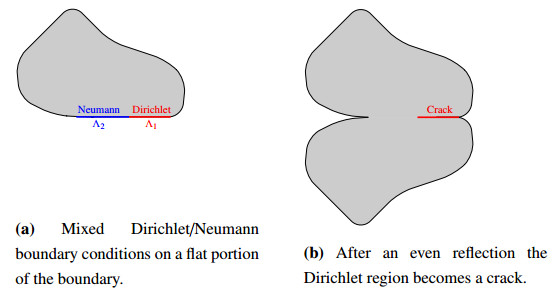









 DownLoad:
DownLoad:
